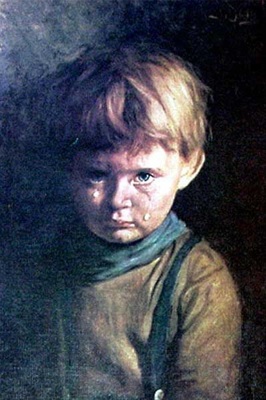Normally a chip-pan blaze would merit nothing more than a couple of paragraphs in a local newspaper. What transformed this story into a page lead in Britain’s leading tabloid was the intervention of Ron Hall’s brother Peter, a firefighter based in Rotherham. A colleague of Peter’s, station officer Alan Wilkinson, said he knew of numerous other cases where prints of the ‘Crying Boy’ had turned up, undamaged, in the ruins of homes destroyed by fires.
 Accompanying the article was a photograph of a ‘Crying Boy’, with the caption: “Tears for fears… the portrait that firemen claim is cursed.” The firemen concerned had not actually used the word ‘cursed’, but nevertheless the newspaper report had helped to give the story a certain level of credibility. The paper added that an estimated 50,000 ‘Crying Boy’ prints, signed ‘G Bragolin’, had been sold in branches of British department stores, particularly in the working class areas of northern England. Examples could be seen hanging in the front rooms of family homes across the nation, and one story even suggested a quarter of a million had been sold.
Accompanying the article was a photograph of a ‘Crying Boy’, with the caption: “Tears for fears… the portrait that firemen claim is cursed.” The firemen concerned had not actually used the word ‘cursed’, but nevertheless the newspaper report had helped to give the story a certain level of credibility. The paper added that an estimated 50,000 ‘Crying Boy’ prints, signed ‘G Bragolin’, had been sold in branches of British department stores, particularly in the working class areas of northern England. Examples could be seen hanging in the front rooms of family homes across the nation, and one story even suggested a quarter of a million had been sold.On 5 September 1985, The Sun ran its follow-up, reporting that scores of “horrified readers claiming to be victims of the ‘Curse of the Crying Boy’ had flooded [the paper] with calls… they all feared they were jinxed by having the print of a tot with tears pouring down his face in their homes.” Readers were left with an overwhelming impression of a supernatural link, reinforced by the use of words like ‘curse’, ‘jinx’, ‘feared’ and ‘horrified’.
Typical of these additional stories was that told by Dora Mann, from Mitcham, Surrey, who claimed her house was gutted just six months after she bought a print of the painting. “All my paintings were destroyed – except the one of the Crying Boy,” she claimed. Sandra Kaske, of Kilburn, North Yorkshire, said that she, her sister-in-law, and a friend had all suffered disastrous fires since they acquired copies. Another family, from Nottingham, blamed the print for a blaze which had left them homeless. Brian Parks, whose wife and three children needed treatment for smoke inhalation, said he had destroyed his copy after returning from hospital to find it hanging – undamaged, of course – on the blackened wall of his living room.
As the stories accumulated, new details emerged that encouraged the idea that possession of a print put owners at risk of fire or serious injury. One woman from London claimed she had seen her print “swing from side to side” on the wall, while another from Paignton said her 11-year-old son had “caught his private parts on a hook” after she bought the picture. Mrs Rose Farrington of Preston, in a letter published by The Sun, wrote: “Since I bought it in 1959, my three sons and my husband have all died. I’ve often wondered if it had a curse.”
Another reader reported an attempt to destroy two of the prints by fire – only to find, to her horror, that they would not burn. Her claim was tested by security guard Paul Collier, who tossed one of his two prints onto a bonfire. Despite being left in the flames for an hour, it was not even scorched. “It was frightening – the fire wouldn’t even touch it,” he told The Sun. “I really believe it is jinxed. We feel doubly at risk with two of these in the house [and] we are determined to get rid of them.”
No comments:
Post a Comment